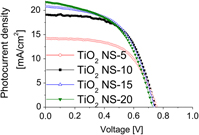Crossref Citations
This article has been cited by the following publications. This list is generated based on data provided by
Crossref.
Xia, Ting
Zhang, Chi
Oyler, Nathan A.
and
Chen, Xiaobo
2014.
Enhancing microwave absorption of TiO2 nanocrystals via hydrogenation.
Journal of Materials Research,
Vol. 29,
Issue. 18,
p.
2198.
Wang, Wenguang
Zhang, Haiyan
Wang, Rong
Feng, Ming
and
Chen, Yiming
2014.
Design of a TiO2 nanosheet/nanoparticle gradient film photoanode and its improved performance for dye-sensitized solar cells.
Nanoscale,
Vol. 6,
Issue. 4,
p.
2390.
Yang, Long
Zhai, Bao-gai
Ma, Qing-lan
and
Huang, Yuan Ming
2014.
Effect of ZnO decoration on the photovoltaic performance of TiO2 based dye sensitized solar cells.
Journal of Alloys and Compounds,
Vol. 605,
Issue. ,
p.
109.
Galindo, Emilio G.
Ariza, María J.
De las Nieves, F.J.
and
García-Salinas, María J.
2015.
Effects of multilayer coating and calcination procedures on the morphology of dye-sensitized solar cell semiconductor photoelectrodes.
Thin Solid Films,
Vol. 590,
Issue. ,
p.
230.
Kunugi, Yoshihito
Kato, Yoshitaka
Uematsu, Hiroya
and
Shimoyama, Yuki
2015.
Fabrication of Aqueous TiO2 Ink and its Patterning with Inkjet Printer.
Journal of Photopolymer Science and Technology,
Vol. 28,
Issue. 3,
p.
403.
Shah, Athar Ali
Umar, Akrajas Ali
and
Salleh, Muhamad Mat
2016.
Efficient quantum capacitance enhancement in DSSC by gold nanoparticles plasmonic effect.
Electrochimica Acta,
Vol. 195,
Issue. ,
p.
134.
Zhai, Bao-gai
Yang, Long
and
Huang, Yuan Ming
2017.
Improving the Efficiency of Dye-Sensitized Solar Cells by Growing Longer ZnO Nanorods on TiO2 Photoanodes.
Journal of Nanomaterials,
Vol. 2017,
Issue. ,
p.
1.
Prasad, M.B. Rajendra
Tamboli, Parvin S.
Ingle, Ravi V.
Diwate, Kiran D.
Baviskar, Prashant K.
Sankpal, B.R.
Mohite, K.C.
Jadkar, Sandesh R.
and
Pathan, Habib M.
2017.
Geometrical thickness of titania photoanode as an influential parameter in controlling the photovoltaic performance of CdS Quantum Dot Sensitized Solar cells.
Current Applied Physics,
Vol. 17,
Issue. 12,
p.
1691.
Chamanzadeh, Z.
Noormohammadi, M.
and
Zahedifar, M.
2017.
Enhanced photovoltaic performance of dye sensitized solar cell using TiO2 and ZnO nanoparticles on top of free standing TiO2 nanotube arrays.
Materials Science in Semiconductor Processing,
Vol. 61,
Issue. ,
p.
107.
Ma, Qing-lan
Ma, Shuqing
and
Huang, Yuan Ming
2018.
Enhanced photovoltaic performance of dye sensitized solar cell with ZnO nanohoneycombs decorated TiO2 photoanode.
Materials Letters,
Vol. 218,
Issue. ,
p.
237.
Lokman, Muhammad Quisar
Shafie, Suhaidi
Shaban, Suraya
Ahmad, Fauzan
Jaafar, Haslina
Mohd Rosnan, Rizuan
Yahaya, Hafizal
and
Abdullah, Shahrum Shah
2019.
Enhancing Photocurrent Performance Based on Photoanode Thickness and Surface Plasmon Resonance Using Ag-TiO2 Nanocomposites in Dye-Sensitized Solar Cells.
Materials,
Vol. 12,
Issue. 13,
p.
2111.
Fallah, Milad
Maleki, Iraj
Zamani-Meymian, Mohammad-Reza
and
Abdi, Yaser
2020.
Enhancing the efficiency of dye-sensitized solar cell by increasing the light trapping and decreasing the electron-hole recombination rate due to Ag@TiO2 core-shell photoanode structure.
Materials Research Express,
Vol. 7,
Issue. 1,
p.
016409.
Duerto, Isolda
Barrios, Daniel
Garín, Javier
Orduna, Jesús
Villacampa, Belén
and
Blesa, María-Jesús
2020.
Difunctionalized dyes for DSSCs based on two different scaffolds: p-tert-butylcalix[4]arene or isophthalic acid.
Dyes and Pigments,
Vol. 182,
Issue. ,
p.
108530.
Fan, Xiaojuan
2022.
Flexible dye-sensitized solar cells assisted with lead-free perovskite halide.
Journal of Materials Research,
Vol. 37,
Issue. 4,
p.
866.
Mak, Chun H.
Yun, Jung‐Ho
Chung, Hoi Y.
Ng, Yun H.
and
Hsu, Hsien‐Yi
2022.
Atomic and Nano Scale Materials for Advanced Energy Conversion.
p.
449.
